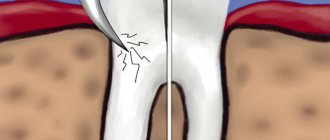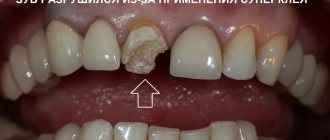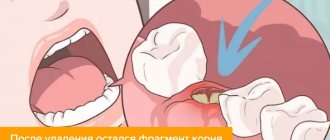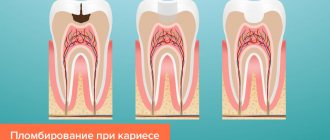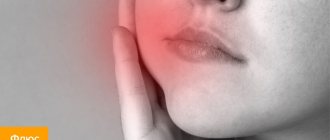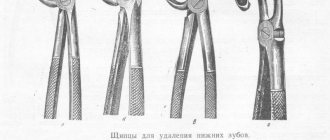Tooth root removal can be very simple or very complex. It all depends on the patient’s condition, his teeth and jaw bones. If the bone has partially resolved, then only a first-year medical student will not be able to cope with the operation. It’s another matter if the root of the tooth is fractured as a result of mechanical damage, or if it is intact but located deep in the alveolus. Mechanical damage can be caused by trauma (strong impact), or improper previous treatment.
The operation to remove a tooth root from the upper jaw has its own specifics; procedures vary depending on the type of tooth (incisors, canines, chewing teeth). The surgeon uses various tools to remove the roots of teeth: S-shaped, bayonet-shaped forceps. The latter are especially actively used when removing tooth roots from the upper jaw. In some cases, before the actual removal of the tooth root, it is divided into parts (usually using a drill). Tooth root removal is different from the process of removing an entire tooth and is usually more labor intensive.
Some patients ignore surgery to remove the root of the tooth if the crown part is no longer there. Motivation varies - usually the patient expects that the remaining tooth will come out on its own over time. Indeed, tooth fragments tend to come out on their own, but the root is not a fragment. It is often observed that the patient comes with an already drawn-out root - then it is necessary to make an incision in the gum to gain access to it. The root of the tooth itself, if not removed in a timely manner, can provoke severe pain and inflammation. Remember: the tooth root does not dissolve!
Many Moscow clinics take on any, even the most complex cases. The experience and qualifications of doctors - specialists with extensive experience - will not allow them to complicate the operation themselves by causing mechanical damage to the tooth root or making mistakes when removing it. But they can correct other people's mistakes. Tooth root removal can be performed with forceps, elevators, or, when previous techniques have failed, by sawing.
Removing the root of a tooth in the upper and lower jaws has technological differences. For different teeth (canines, incisors, chewing teeth), forceps of different shapes (straight, S-shaped, bayonet-shaped) and elevators (working on the principle of a lever) are used. The procedure itself is performed under local or general anesthesia. The dentist will choose a method for removing the roots of the teeth, and anesthetic agents are selected in such a way as to eliminate the likelihood of side effects (individual intolerance, allergic reactions).
If the root of the tooth is already overgrown, you will have to open it by cutting into the gum. This operation is also performed under anesthesia. After surgery, stitches may be placed and special medications may be used to speed up gum healing. Doctors will remove the root of any tooth, regardless of why only the crown was removed. Painless, fast, high quality.
When is a tooth root 100% subject to extraction?
Tooth root removal is performed if:
- the root is softened below the gum level,
- the root of the tooth is below the level of the surrounding bone tissue,
- the root of the tooth has cracks
:
- the root of the tooth is chipped
:
- the root of the tooth is severely damaged, for example as a result of canal treatment with resorcinol
:
- There are various inflammatory processes around the root and under the root of the tooth - cyst, cystogranuloma
:
- the root of the tooth is mobile,
- there is a deep dental pocket.
What happens if the root remains under the gum?
- inflammation of the pulp is a consequence of infection, accompanied by inflammation of the nerve and rotting of the root from the inside. In case of purulent pulpitis, urgent removal of the root and nerve is recommended;
- Periodontitis is a common gum disease in which the root gradually becomes loose, leaving an empty space around it where infection accumulates. The root gradually moves away from the tooth. With such a problem, the chances of saving the root part are extremely small. If periodontitis is not treated in a timely manner, the inflammatory process can affect other systems and organs;
- toxic effects of filling residues are a common occurrence when a tooth with a filling breaks off and particles of material remain in its place. They react with the mucous membrane and gums, provoking an even greater pathological process. Not only the root of the lost crown becomes inflamed, but also the neighboring roots and nerves;
- cyst is a consequence of the inflammatory process in the gum and pulp area. The destruction spreads to the entire tooth and it is no longer attached to the root. Rotting gradually spreads to both the root and the space around it.
How is tooth root removal done?
Are there any features or important points when removing a tooth root? Of course, any removal - be it tooth extraction, wisdom tooth removal, impacted tooth or tooth root should be carried out as atraumatically as possible, preserving the tissue structure
that surround a tooth or tooth root:
The goal of atraumatic root removal is to preserve bone
. Removal should be done painlessly.
The clinics of the German Implantology Center are supporters of atraumatic and painless removal. Our technologies have been proven over the years, and our patients feel very comfortable with them. It is no secret that many patients have fears about removal, and these fears sometimes postpone the surgical stage of treatment for a long time. In our clinics, we help patients overcome these fears. The patient may not be afraid of anything - both in the case of a single extraction and in case of multiple extractions of teeth
:
What is atraumatic tooth root removal?
What instruments does the surgeon use to achieve atraumaticity? For atraumatic removal, special instruments are used - thin, neat and elastic elevators that can minimally invasively penetrate and expand the periodontal tissue that connects the tooth root directly to the jaw. Using special instruments, the periodontal ligaments are cut so that the root can be removed as carefully as possible, in its “pure form.”
The vestibular plate that surrounds the bone is very thin. And we work with her carefully when removing teeth. It may also be necessary to saw the root of the tooth so that it can be removed in pieces. Sawing can be carried out with oscillating ultrasonic attachments - ultrasonic knives. Cutting the root of a tooth can be done quite effectively with a high-quality thin surgical dental bur, which has a certain length.
After cutting the root, the medial wall of the root is first removed, and then the vestibular wall of the root is removed. This allows for maximum preservation of surrounding tissue.
Then, after such removal, you can preserve the tooth socket or place an implant so that the bone is preserved as much as possible. Preservation of the tooth socket is carried out if there are no conditions for installing an implant at once, or if the patient undergoes delayed implantation.
If the roots of wisdom teeth are removed, the socket is not preserved; it is enough to remove them as atraumatically as possible. Let's talk about this in a little more detail.
Features of root removal of decayed wisdom teeth
Are there any difficulties when removing the roots of wisdom teeth? Removing the roots of wisdom teeth requires that the surgeon has sufficient experience. Often the roots of these third molars (wisdom teeth) are located close to the mandibular canal. Often the roots of molars are adjacent to the upper or lateral wall of the mandibular canal. The configuration of wisdom tooth roots is extremely diverse and sometimes extremely difficult to remove:
Therefore, when removing the roots of wisdom teeth, it is imperative that the patient undergo a CT scan. And the surgeon, as I said, needs to have some experience in surgical training in order to avoid the risks of removing the roots of such teeth and carry out the manipulation as efficiently as possible.
Like any root teeth, the roots of wisdom teeth are removed by cutting them along the roots. Wisdom teeth do not have problems because they are close to the angle of the lower jaw and there are strong cortical plates there. When I talked about thin vestibular walls, this comparison refers to the aesthetic zone of the smile, to the frontal group of teeth, including the premolars:
.
What to do if the gum grows on the tooth?
- do not wait until the process worsens, but quickly contact a professional dentist;
- the specialist will perform a visual examination of the tooth, send for an x-ray, ultrasound of the root to determine further actions;
- often overgrown and broken teeth are removed, but the gum tissue is first cut;
- if the tooth is healthy, after cutting the gum, the dentist installs a pin on top of which the dental crown is fixed;
- If the tooth cannot be saved, the root is extracted. The surgeon cuts the upper part of the tooth with an elevator (a special tool similar to a thin spatula), the root is grabbed with special dental forceps and gradually removed. The wound is then disinfected.
The operation to dissect the gums is carried out quickly, under local anesthesia, sometimes with sutures. After treatment, special preparations are applied to the wound to speed up the tissue healing process. A few weeks later, the surgeon examines the wound, removes the sutures and recommends a certain type of prosthetics or implantation to the patient.
What the patient needs to understand before root removal
You need to assess the health risks, you need to talk to the attending surgeon, find out about his experience. Quite often, tooth root removal is carried out, unfortunately, with the following negative consequences:
- gums are torn
- fractured bony vestibular plate
Sometimes when visiting such patients, you get the feeling that the tooth was not removed, but knocked out with something. There were cases when a patient’s extraction began in some clinic, and there, in the middle of the patient’s appointment, the doctor announced that he was unable to remove it, and the patients came to us in this form to remove the root of a tooth that was already in the extraction stage.
When removing the roots of wisdom teeth, you may face risks such as jaw fracture. One of the common risks of removing the roots of 3 molars is damage to the mandibular nerve
, leading to cuts and numbness in areas of the jaw. There is a risk of damaging the artery on the lingual side.
If, when a tooth is removed, a root or part of it is left behind, what should you do?
According to Russian treatment standards, the tooth root cannot be left during extraction. That is, if the patient was left with a root or part of it during removal, then this is considered a poorly performed surgical procedure.
In European countries there are doctors who agree that if there is no inflammation on the tooth and if the root part is not infected, and removal of the root leads to trauma, then only the cortical part of the root is removed, and the other part remains in the bone.
If the patient is left with a part of the root that is infected, then this is a problem. A cyst may develop and inflammation may develop. If the apical part was not infected, then everything heals and does not bring any trouble to the patient.
Tooth root without crown part
Can a tooth root without a crown cause inflammation in the gums or bone? Of course it can. There is a canal at the root of the tooth; if this canal is infected, then the problem will develop into a negative prognosis.
Inflammation, suppuration, periostitis, osteomyelitis - diseases can develop due to an infected tooth root. And the source of infection at the root must be removed; if it is impossible to remove the infection and preserve the root, then it must be removed.
Overgrowth of teeth by gums - the main reasons
- lack of dental treatment for a broken tooth;
- an insufficiently erupted wisdom tooth that is overgrown with tissue and puts pressure on the entire dentition. In this case, there is a high risk of misalignment and other orthodontic problems;
- patient's refusal to remove the root.
All of the above points lead to the fact that under the gum there is a destroyed part of the crown and root, which also brings a lot of problems to the patient.
The main reason why a tooth becomes overgrown with gum is a person’s neglectful attitude towards the condition of the oral cavity. Poor nutrition, bad habits, diseases, and insufficient hygiene lead to teeth becoming fragile, they are easy to break at the slightest pressure, and roots remain underneath them, which very quickly become overgrown with gum tissue.
Is implantation possible after tooth root removal?
Yes, of course it is possible. And we at the clinics of the German Implantology Center widely use implantation after tooth root removal. Our conditions allow us to carry out implantation in such cases. And if we can achieve primary stability of the implant, then in 90% of cases
After removal, we immediately install the implant. We have rolled out the technology to perfection and gives excellent results.
Of course, with the exception of wisdom teeth, no implant is placed after their removal. But, by the way, wisdom teeth in this situation can be extremely useful, since they... can be transplanted to the place of the problem tooth being removed! Dental transplantation has been practiced in the clinics of the German Implantology Center since 2017, and our specialists have accumulated a wealth of clinical experience. Let's talk about this a little more.
An alternative to implantation is autotransplantation of wisdom teeth
Don't rush to remove your wisdom teeth. Firstly
, there must be clear indicators for their removal.
Secondly
, you don’t need to follow fashion, trends and delete eights just because “a girlfriend or friend deleted them and it’s cool.” There are a number of moments in life when wisdom teeth come to our aid.
It is not for nothing that nature has created a number of organs that duplicate each other in our body, for example, we have two lungs, two kidneys, which in case of problems with one lung/kidney come to our aid. Also with wisdom teeth: if a person (for some reason) has problems with the chewing group of teeth, for example, caries has destroyed the sixth or seventh tooth, then eights can come to the rescue. How so? After all, wisdom teeth are not involved in the chewing process. Yes, you are right here. But a wisdom tooth can serve as a donor, and it can be transplanted into place of a tooth with destroyed roots. Fantastic? No, advanced technologies in dentistry. This is called autotransplantation.
In the following video we show in detail the dental transplant surgery. The roots of two sixths of the patient's teeth had just been destroyed, and they were replaced by the patient's own wisdom teeth. And, by the way, this patient at the end of the video gives a detailed review after 1 year after the operation. Look, this is useful:
What happens if you don’t remove the root on which the gum has grown?
If the root remains under the gum, the decay process will continue indefinitely, spreading to neighboring teeth. At the same time, the person will have an unpleasant, putrid odor from the mouth. Porous particles attract harmful bacteria and food particles, causing caries to develop. In almost 100% of cases, an inflammatory process forms at the tops of rotting roots, a bag of pus, which sooner or later will result in gumboil.
Thus, the only correct solution when gums grow on a tooth is to contact an experienced dentist who will help solve the problem, save the damaged crown and prevent the development of the inflammatory process.

